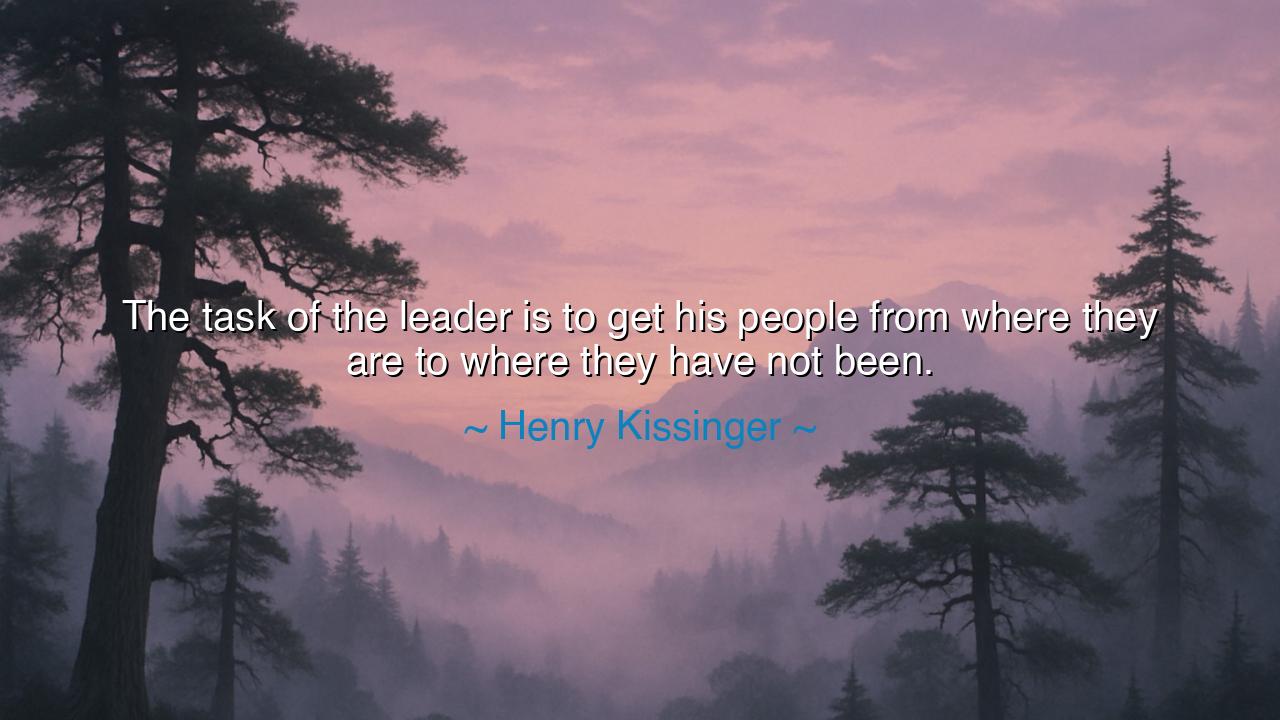
The task of the leader is to get his people from where they are
The task of the leader is to get his people from where they are to where they have not been.






“The task of the leader is to get his people from where they are to where they have not been.” Thus spoke Henry Kissinger, a man of both diplomacy and destiny, who walked the narrow path between nations in an age of peril and transformation. His words, though born in the crucible of politics, reach far beyond the halls of power. They speak to the eternal essence of leadership—that sacred duty to guide others not merely through the familiar, but toward the unknown. For a leader’s true test is not in maintaining what is, but in envisioning what could be, and in leading souls across that uncertain bridge from comfort to change.
To get his people from where they are to where they have not been is to awaken them from the sleep of familiarity. Most men cling to what is known, fearing the uncertain future as one fears the dark. But the leader, armed with vision and courage, must see beyond that darkness and summon others to follow. It is not enough to command; one must inspire. The leader’s eyes must pierce the horizon, and his heart must bear the weight of hope. He must walk first into the unknown, carving a path through confusion and fear, until those who follow learn to walk beside him with faith.
This truth has echoed through every age. When Moses led his people from Egypt, he did not promise them ease; he promised them transformation. The journey through the wilderness was not merely a passage of distance, but a passage of spirit—from slavery to freedom, from fear to faith, from what was to what could be. The people grumbled, they doubted, they faltered; yet Moses pressed forward, for he knew the leader’s burden: to see the Promised Land long before others can imagine it, and to guide them toward it even when they resist. Thus, Kissinger’s words capture the same eternal law—the leader must be the bridge between the known and the possible.
Henry Kissinger, who lived through war and diplomacy, knew that leadership often unfolds in uncertainty. As a strategist and statesman, he sought to navigate the shifting tides of a world divided by ideologies and fear. His quote was born not from theory but from experience: he saw that the role of a leader was not to preserve balance, but to move people forward, even when the path was unseen. A true leader must confront the inertia of nations, the resistance of hearts, and the seduction of the status quo. To lead is to disrupt, to challenge, to call forth courage in those who do not yet know they possess it.
Yet this task demands more than vision—it demands empathy. To move people from where they are, a leader must first understand where they stand: their fears, their hopes, their pain. One cannot drag others into the unknown; one must walk with them. Leadership is not tyranny, but transformation. The wise leader becomes both teacher and servant, lighting the way with his own conviction. He must blend patience with purpose, knowing that progress without understanding is mere force, and that the heart must be won before the body can move.
Consider Sir Ernest Shackleton, who led his men through the frozen hell of Antarctica after their ship, Endurance, was trapped and destroyed by ice. He promised them survival when death seemed certain. Through storms, hunger, and despair, he guided them not only by skill but by faith—faith that they could endure, faith that the impossible could be done. He brought every one of his men home alive. Shackleton was a leader in Kissinger’s image: one who led his people to where they had not been—not to comfort, but to triumph over fear and impossibility itself.
Thus, O seeker of wisdom, learn this sacred truth: leadership is not about position, but about direction. It is the art of guiding hearts through the fog of uncertainty toward a greater dawn. Whether in the household or the battlefield, the classroom or the nation, your task as a leader is the same—to see the unseen and to believe before others dare to. You must become both visionary and voyager, builder and believer, until others rise to follow your light.
The lesson is clear: To lead is to journey first. To guide others to new heights, you must first climb within yourself. Do not fear the unknown; embrace it as the realm where greatness is born. Speak vision into the ears of the weary, and courage into the hearts of the doubtful. For as Henry Kissinger taught, the leader’s sacred task is to bring his people not merely forward, but upward—to carry them from the safety of the known into the promise of the new. And in that journey, both leader and follower alike are transformed.






AAdministratorAdministrator
Welcome, honored guests. Please leave a comment, we will respond soon